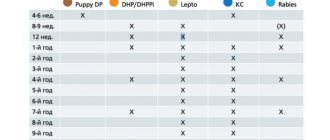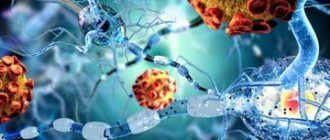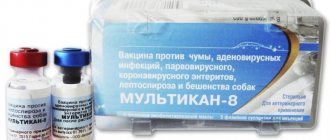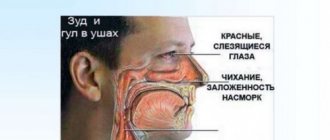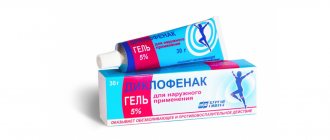Compound
Injection:
- papaverine hydrochloride - 20 mg per 1 ml of medicinal liquid;
- D,L-methionine;
- disodium edetate;
- water for injections.
Pills:
- papaverine hydrochloride - 10 mg in 1 tablet;
- rafinated sugar;
- potato starch;
- stearic acid;
- talc.
Rectal suppositories:
- papaverine hydrochloride - 0.02 g in 1 suppository weighing 1.25 g;
- emulsifier No. 1;
- cosmetic stearin;
- hard fat.
Use in pregnant and lactating women
During pregnancy, Papaverine injection solution is used very rarely, only if there are serious indications for it. Injections are given under the strict supervision of a doctor. Most often, expectant mothers are prescribed Papaverine in the form of rectal suppositories to relieve uterine hypertonicity.
During breastfeeding, Papaverine injections are given under the supervision of a doctor. Studies have not revealed any negative effects on infants, however, self-medication is contraindicated; the drug must be prescribed by a doctor.
Release form
- Papaverine in tablets of 0.01 g or 0.04 g, depending on the target audience of patients (the first are used in pediatric practice after 6 months), which are packaged in contour blisters of 10 pieces. The oral form has a slightly bitter taste, is white in color and has no odor at all.
- Solution for injection 2% in ampoules of 2 ml. A cardboard package usually contains 10 pieces and instructions for use of the pharmaceutical drug.
- Rectal suppositories or suppositories for insertion into the rectum, 0.02 g each; secured in blisters made of PVC or aluminum foil, 10 pieces each. A plate with the medicine and an annotation are placed in a cardboard box.
Instructions for the use of "Papaverine" in injections
The drug, produced in ampoules, is a sterile solution of papaverine hydrochloride 2%, ready for parenteral administration. Each 2 ml ampoule contains 40 mg of active substance - this amount is equivalent to a single dose for an adult. The same amount of papaverine hydrochloride is contained in the tablet.
When using a whole undiluted solution, the drug can only be administered subcutaneously or intramuscularly. After dilution, it is allowed to give an intravenous injection of Papaverine. The dosage depends on the patient's age:
- adults and adolescent children can be given no more than 2 ml of medication at a time, with the maximum daily dose being 4-8 ml;
- children 7-10 years old are allowed to give 0.5-0.75 ml of the drug no more than twice a day;
- babies from six months to two years – 0.25 solution up to four times a day;
- children 2-4 years old - up to 0.5 ml of medication twice a day;
- children from 4-7 years old - 0.5 ml no more than two times.
pharmachologic effect
Papaverine hydrochloride (Wikipedia indicates that the INN of the drug corresponds to the name of the main active component) is an opium alkaloid that affects smooth muscle elements and causes them to relax, therefore the pharmacological group of the drug is defined as myotropic antispasmodics .
The mechanism of the therapeutic action of the biological substance is to influence the secondary messengers (messengers) of the transmission of muscle excitation. Papaverine inhibits PDE (phosphodiesterase), due to which cAMP calcium ions decreases ; in response to such biochemical changes, the smooth muscles of the internal organs (digestive tube, respiratory and genitourinary systems and vascular bed) relax, their tone decreases .
Pharmacopoeia is a set of mandatory rules and official regulations that guide the manufacture, testing, storage and prescription of medicines to patients. Since the main biologically active component of a pharmaceutical drug is potent, in relation to Papaverine hydrochloride the pharmacopoeia includes the following points for determining the authenticity of a chemical substance:
- Physical characteristics – white crystalline powder, odorless, with a slightly bitter taste.
- Solubility – soluble in water within 40 hours, slightly soluble in 95% alcohol, soluble in chloroform and practically insoluble in ether.
- The acidity of a 2% solution of Papaverine hydrochloride is 3.0-4.5 (determined potentiometrically).
- Chemical authentication control - 0.05 g of a pharmaceutical drug is placed in a porcelain bowl, moistened with a couple of drops of high concentration nitric acid, after which a yellow color should appear, which when heated in a water bath changes to orange.
- Presence of organic impurities - dissolution and color change test in 5 ml of concentrated sulfuric acid.
Selective vasoactive drugs
Papaverine hydrochloride is a myotropic antispasmodic agent. The drug is an inhibitor of the phosphodiesterase enzyme and causes intracellular accumulation of cAMP, which promotes relaxation of smooth muscle fibers of the abdominal organs and peripheral vessels. With intracavernous administration of a 2% solution of papaverine hydrochloride from 20 to 100 mg (1-5 ml), blood flow to the cavernous bodies of the penis increases, which causes an erection. Since 1982, the drug has been used in the treatment of erectile dysfunctions of various (mostly organic) origins. The effective dose is selected individually, starting from 20 mg (1 ml). This amount of the drug in some cases can cause a full erection in patients with lesions of the nerve pathways, for example, diabetic neuropathies. The optimal dosage of the drug is one that ensures a full erection lasting from 30 to 90 minutes. Moreover, pharmacologically induced erection persists in men during this period of time even after ejaculation.
In the 80s of the last century, the drug was widely used in the treatment of erectile dysfunction in men. However, it soon became clear that intracavernosal injections of papaverine hydrochloride lead to numerous complications and side effects, which significantly limits its use in patients, especially for long-term treatment. The most serious complication is the development of a prolonged erection that lasts for more than 4 hours. In some cases, a man can make it disappear on his own: by taking a bath with cool water and/or using physical activity on the lower limbs (squats, etc.).
An erection lasting more than 6 hours indicates priapism. With intracavernous administration of papaverine hydrochloride, the probability of its occurrence is 5-7%. Long-lasting priapism leads to destructive changes in the cavernous bodies of the penis with the gradual replacement of the smooth muscles of the cavernous bodies with fibrous tissue, which subsequently entails severe and persistent violations of erectile function.
The main treatment for this complication is aspiration of clots and stagnant blood from the corpora cavernosa using injection needles. If an erection persists, a solution of one of the adrenergic agonists is additionally administered: adrenaline or norepinephrine (0.05-0.1 mg), dopamine (0.04-0.12 mg) intracavernosally to cause a narrowing of the arteries supplying the penis.
Priapism lasting over 12 hours can be stopped by using 10% metaraminal according to the following scheme: 1 ml of the drug is dissolved in 10 ml of saline and injected into the corpus cavernosum through a butterfly needle at a rate of 0.75 ml/min. The maximum single dose of metaraminal is 3 ml. As a rule, these actions are sufficient to relieve pharmacogenic priapism. Surgical treatment methods are indicated when conservative measures are unsuccessful or within a period of more than 24-36 hours from the development of priapism. Most often, an anastomosis is performed between the corpus cavernosa and the great saphenous vein of the lower limb (usually a bilateral saphenous-cavernous bypass is performed) or an anastomosis is created between the cavernous and spongy bodies. After surgical treatment of priapism, complete impotence develops in approximately 50% of cases, and it has not yet been established whether it is a consequence of the operation or a complication of prolonged priapism.
Other early complications of intracavernosal use of papaverine hydrochloride are hematomas at the injection site, a decrease in blood pressure due to the release of the vasodilator into the general bloodstream. Late complications include cardiac arrhythmias and toxic damage to the liver and kidneys. However, the greatest problems are associated with the development of fibrosis and deformations of the corpora cavernosa, which are observed in 16-57% of patients with regular use of the drug for more than 12 months (E. Wespes, 1989). Intracavernous administration is contraindicated in patients with impaired atrioventricular conduction of the heart, blood diseases, and Peyronie's disease.
Alprostadil (Caverject) is a synthetic prostaglandin E1. Available in the form of sterile alprostadil powder for intracavernosal administration, 10 and 20 mcg in a bottle complete with a solvent.
Prostaglandin E1 (alprostadil) stimulates adenylate cyclase, which leads to an increase in cAMP, which causes relaxation of the smooth muscle fibers of the cavernous arteries and sinusoids of the cavernous bodies, ensuring the development of penile erection.
Main indications for the use of alprostadil.
For diagnostics:
- As an intracavernous test for screening diagnostics of genital blood flow disorders.
- As a pharmacological load during Doppler ultrasound of penile vessels and phalloarteriography.
For treatment:
- As an alternative to surgical treatment for severe disorders of the blood supply to the cavernous bodies.
- As an effective remedy that provides a full erection even in the absence of sexual desire.
- For the purpose of correcting severe erectile dysfunction in patients with coronary pathology taking nitro drugs.
Intracavernous administration of caverject is used in the treatment of the most severe disorders of erectile function, primarily in cases of pathology of genital blood flow and lesions of structures associated with the innervation of the penis. Depending on the nature of the disorder, the dose of the drug that provides an erection sufficient for sexual intercourse can range from 2.5 to 60 mcg. The selection of an effective dosage is carried out in the doctor's office, starting with an intracavernosal injection of 5-10 mcg of alprostadil.
Next »
Pharmacodynamics and pharmacokinetics
The active component is quickly and almost completely absorbed by any route of administration of the drug into the body. Once in the bloodstream, it binds to plasma proteins (90% of the total biologically active substance), due to which it easily passes through histohematic barriers. It undergoes biotransformation in the liver. The half-life ranges from 30 minutes to 2 hours, depending on the auxiliary components of the pharmaceutical drug. It is excreted primarily by the kidneys in the form of metabolic products.
Papaverine
A person who is more or less familiar with the intricacies of Latin terminology knows that “papaver somniferum” means nothing more than poppy somniferum. Therefore, the guess that papaverine is an alkaloid obtained from the opium poppy would be absolutely correct. It would be naive to believe that efficient pharmacologists will ignore the opportunity to use the antispasmodic properties of this substance for the benefit of humanity. Thus, the drug papaverine was obtained, which reduces smooth muscle tone and has antispasmodic, vasodilating and hypotensive effects. The pharmacological effect of papaverine is based on its ability to suppress the enzyme phosphodiesterase and potentiate the accumulation of 3,5-adenosine monophosphate in cells while simultaneously reducing the level of calcium ions. All this affects the smooth muscles of internal organs (digestive and genitourinary tract, respiratory system) and blood vessels better than any psychotherapist: they relax, their excess tone decreases during spastic conditions. In high concentrations, papaverine can reduce myocardial excitability and slow down atrioventricular conduction. The drug has a weak effect on the central nervous system, providing only a barely noticeable sedative effect.
Possessing the property of easily passing through histohematic barriers, the drug is quickly and completely absorbed from the injection site and distributed in the body.
The drug under the name “papaverine” is produced by purely domestic pharmaceutical companies in three dosage forms: tablets, solution for injection and rectal suppositories. For tablets, the recommended daily dose is 40-60 mg (adults) and 20 mg (children aged 10 to 14 years). The maximum doses for the tablet form are: 200 mg (highest single) and 600 mg (daily). Papaverine solution can be administered intravenously, intramuscularly or subcutaneously. The time interval between administrations of the drug should be at least 4 hours; adults are given 1-2 ml of a 2% solution (0.02-0.04 g) at a time, and for elderly patients the initial single dose is 0.5 ml. For children from 1 to 12 years old, the highest single dose is 0.2-0.3 g per 1 kg of weight. Suppositories are found in 1-2 pieces. (equivalent to 0.02-0.04 g) 2-3 times a day.
While taking papaverine, you should completely avoid alcohol.
Indications for use of Papaverine
- spasm of smooth muscles of the abdominal organs (especially often with cholecystitis , spastic colitis or pylorospasm );
- hypertensive crisis (in combination conservative therapy);
- renal colic;
- endarteritis;
- spasm of the peripheral vascular bed;
- decrease in the lumen of blood vessels in the brain due to contraction of the muscular layer of the arteries;
- angina pectoris;
- bronchospasm;
- reduction of arterial renal inflow of vascular origin;
- urinary retention due to spasm of the urinary tract.
Indications for use also include the stage of premedication before surgical interventions in the abdominal cavity, proctological and urological manipulations. What it is used for – relaxation of smooth muscle elements (for more details, see paragraph “Pharmacological action”).
Contraindications
- intolerance to the constituent components of the drug;
- intracardiac conduction disorders, especially atrioventricular block ;
- hypersensitivity to a pharmaceutical drug;
- glaucoma;
- severe liver failure ;
- old age (as there is a significant risk of developing hyperthermic syndrome);
- children up to 6 months of age.
Additional restrictions for use (it is recommended to use only under the constant supervision of qualified medical professionals and regular diagnostic examinations):
- history of recent traumatic brain injury
- chronic renal failure ;
- states of shock;
- hypothyroidism;
- supraventricular tachycardia ;
- benign prostatic hyperplasia ;
- insufficiency of adrenal gland functionality.
Side effects
- From the cardiovascular system and blood: atrioventricular block , ventricular tachycardia , decreased blood pressure .
- From the gastrointestinal tract: nausea , constipation ( constipation ), bloating , impaired passage through the digestive tube, increased activity of liver transaminases.
- Others: drowsiness , allergic reactions , eosinophilia .
Is there a chance of side effects?
Preparations based on papaverine hydrochloride are considered relatively safe. Side effects from Papaverine injections most often occur due to allergies or an adverse reaction from the gastrointestinal tract. If you believe the reviews, this medicine can cause:
- redness on the skin;
- small itchy rash;
- swelling;
- constipation;
- nausea;
- bloating;
- disturbances of intestinal motility.
In addition, Papaverine has antihypertensive properties, which means that people with low blood pressure need to take the drug with extreme caution. In case of exceeding the daily volume of the drug or overdose, the activity of liver enzymes increases, which leads to eosinophilia. Some patients report drowsiness, dizziness, and hyperhidrosis. If the solution is administered too quickly into a vein, heart rhythm disturbances and the development of atrioventricular block may occur.
A severe overdose may be indicated by symptoms such as double vision, weakness, and increased fatigue. You can get rid of them by carrying out detoxification therapy, which involves gastric lavage, taking sorbents and supporting blood pressure.
About contraindications
All restrictions associated with the use of Papaverine apply to any form of release of the drug. This remedy is contraindicated for diseases and conditions such as:
- high sensitivity to the components of the drug;
- atrioventricular heart block;
- glaucoma;
- chronic liver failure;
- over 65 years of age and under 6 months of age.
In addition to absolute contraindications, it is worth noting a number of other conditions for which it is not recommended to give injections with Papaverine:
- a traumatic brain injury suffered within the last six months;
- state of shock;
- chronic renal and adrenal failure;
- hypothyroidism;
- prostatic hyperplasia;
- tachycardia.
Instructions for use of Papaverine (Method and dosage)
Papaverine tablets, instructions for use
In tablets, the pharmaceutical drug can be prescribed to both adults and children, even the frequency of administration does not change and is 3-4 times a day. The dosage of the oral form of the drug depends on the age category of the patient; the following treatment regimen is used:
- from 6 months to 2 years – 0.005 g per dose;
- 3-4 years – 0.005-0.01 g;
- 5-6 years – 0.01 g;
- 7-9 years – 0.01-0.015 g;
- 10-14 years – 0.015-0.02 g;
- adults – 0.04-0.08 g per dose.
Papaverine suppositories, instructions for use
Hemorrhoids are an extremely unpleasant proctological disease that is associated with thrombosis , inflammatory processes and pathological expansion of the hemorrhoidal veins surrounding the lumen of the rectal outlet. This nosological unit is characterized by a typical clinical picture , which includes impaired bowel movements, itching, and bleeding from the anus. Suppositories with Papaverine will help ease the course of the disease.
The active components of the pharmaceutical drug allow you to relax the smooth muscle elements of the intestine , which facilitates the process of bowel movements, because the lumen of the rectum slightly increases. For the same reason, bleeding is stopped, since hard feces do not injure inflamed hemorrhoids, therefore suppositories with Papaverine for hemorrhoids are a kind of “magic wand”.
In pharmacy kiosks you can find suppositories with different dosages of biologically active substances. The course of conservative treatment should begin with 0.02 g, gradually increasing it to 0.04 g if a smaller amount of the pharmaceutical drug does not have its therapeutic effect. It is not recommended to use more than 3 suppositories per day, this is fraught with the development of adverse side effects and even an overdose, since all incoming medications are extremely well absorbed in the rectal area.
How to use Papaverine Hydrochloride injection solution?
The active component of the pharmaceutical drug has high bioavailability, therefore injections can be done both subcutaneously and intramuscularly, as well as intravenously, the therapeutic capabilities of the drug will not be affected, and the final result will be just as strong. However, it should be determined that the instructions for use recommend subcutaneous injections of Papaverine hydrochloride not into the distal part of the forearm, but into the shoulder or the outer surface of the thigh, since the frequency of administration can cause the appearance of a hematoma. Intramuscular injections of Papaverine can be carried out according to the standard scheme, that is, using the upper lateral quadrant of the buttock.
Before making intravenous injections, the amount of the pharmaceutical prescribed by the doctor should be diluted with 10-20 ml of isotonic sodium chloride . It should also be remembered that Papaverine hydrochloride should be administered very slowly, so as not to cause discomfort in the patient during the injection process.
As a rule, the contents of 1 ampoule (2 ml) of a 2% solution of Papaverine Hydrochloride are injected subcutaneously.
Dosage of solution in ampoules for intravenous and intramuscular administration:
- adults: one-time – 0.1 g, daily – 0.3;
- children from 6 months to 1 year: one-time – 0.005 g, daily – 0.01 g;
- at the age of 2 years: one-time – 0.01 g, daily – 0.02 g;
- 3-4 years: one-time – 0.015 g, daily – 0.03 g;
- 5-6 years: one-time – 0.02 g, daily – 0.04 g;
- 7-9 years: one-time – 0.03 g, daily 0.06 g;
- 10-14 years: one-time – 0.06-0.06 g, daily – 0.1-0.2 g.
Dibazol with Papaverine - how to use?
Dibazol is an antihypertensive drug from the group of peripheral vasodilators , that is, the active components of the pharmaceutical drug have a vasodilatory effect and significantly contribute to lowering blood pressure. Papaverine has similar therapeutic properties in relation to the vascular system, therefore the combination of these drugs is actively used by emergency medical workers to eliminate a hypertensive crisis .
Dibazol with Papaverine is administered intramuscularly or intravenously, because in this way the necessary pharmacological effects of the active ingredients develop much faster than with oral or any other method of use. The relaxing effect of biologically active components can be combined with physiotherapeutic methods, for example, a horizontal position with the leg end lowered, warm foot baths, massage of the lower extremities, and so on.
The dosage of Dibazol with Papaverine to eliminate a hypertensive crisis is 3-5 ml of a 1% solution of Dibazol and 2 ml (contents of 1 ampoule) of a 2% solution of the second pharmaceutical drug. Such a large number of active ingredients can not only reduce blood pressure, but also relieve nausea, pain in the heart and some other manifestations of cardiovascular pathology.
Directions for use and doses
The drug is administered subcutaneously, intramuscularly and intravenously. 1-2 ml of solution is injected subcutaneously and intramuscularly 2-4 times a day. Intravenously - 1 - 2 ml of a 2% solution with preliminary dilution in 10-20 ml of isotonic sodium chloride solution. It should be administered very slowly and carefully, given that the drug can cause the development of atrioventricular block, ventricular extrasystoles and ventricular fibrillation.
A single dose for adults is 0.02-0.04 g (1-2 ml of 2% solution); the interval between administrations is at least 4 hours. For elderly patients, the initial single dose should not exceed 0.01 g. For children from 1 year to 12 years, the maximum single dose is 0.3 mg/kg body weight.
Overdose
Possible symptoms of intoxication with the active components of the drug:
- diplopia (double vision);
- weakness;
- lowering blood pressure;
- drowsiness;
- increased fatigue .
specific pharmaceutical antidote , therefore detoxification therapy and symptomatic treatment . Gastric lavage or consumption of sorbents ( milk , activated carbon , for example) in the first hours after taking oral forms of Papaverine hydrochloride is especially effective. Also, in case of drug overdose, it is important to constantly monitor and, if necessary, artificially maintain blood pressure.
Adverse reactions
The drug is well tolerated by patients, but in some cases, with increased individual sensitivity or exceeding the dose after the injection, side effects may develop:
- Dizziness;
- Constipation;
- Bloating;
- Lethargy, drowsiness;
- Decrease in blood pressure;
- Increased sweating;
- Liver dysfunction, increased activity of organ transminases.
After discontinuing the drug or reducing the dose, all negative reactions disappear.
Interaction
Platiphylline is an antispasmodic, vasodilating, sedative agent, that is, its pharmacological properties are close to Papaverine. Medicines differ only in the mechanisms of therapeutic action, therefore Platyfillin with Papaverine are used in the combined conservative treatment of spastic syndromes, hypertensive crises and other pathological conditions.
No-spa with Papaverine, like Platiphylline, interact well, exerting a synergistic therapeutic effect on the smooth muscle elements of the human body. This combination of pharmaceuticals is especially common in obstetric and gynecological hospitals when there is uterine tone, the threat of spontaneous miscarriage, or excessively active early labor.
In medical publications on neurological topics, there is news that the effectiveness of Levodopa is significantly reduced in combined conservative therapy, for which the use of Papaverine in tablets or in the form of an injection solution against the background of drug treatment of Parkinson’s disease is contraindicated.
The simultaneous use of Papaverine with anticholinergic drugs may result in an increase in the therapeutic effects of the latter, therefore, if their combined use is necessary, dosage reduction or temporary withdrawal of pharmaceutical drugs should be discussed with a qualified specialist.
special instructions
Papaverine hydrochloride significantly improves peripheral blood circulation, which improves trophic processes in individual organs when used locally. This therapeutic ability determines the use of the pharmaceutical drug in bodybuilding . Practical observations of athletes show that it is most effective to use the drug to increase the specific mass of the deltoid and biceps muscles.
The goal of athletes is to have a local effect on a certain part of the muscle, from which injections are given intramuscularly. The optimal dosage is 1-2 injections per week, given 15-20 minutes before intense training. Further, at the very beginning of physical exercise, all efforts should be aimed at the “enriched” muscle, that is, exercise using the “pumping” (blood pumping) system, since the therapeutic effect of Papaverine when used locally is short-lived.
The ingenuity and resourcefulness of the female half of humanity is in no way behind the stronger sex, because Papaverine hydrochloride is used even in cosmetic procedures and home care for the skin. Thanks to increased blood circulation in the peripheral parts of the body under the influence of the pharmaceutical drug, the removal of accumulated fluid is improved, swelling is relieved and metabolic processes are stimulated to some extent. Such therapeutic effects make it possible to use the drug to combat cellulite , eliminate the unpleasant “orange peel” in the buttocks and back of the thigh, and even get rid of a couple of extra pounds.
To obtain this result, leading cosmetologists recommend using caffeine and Papaverine wrap , which can be done even at home. To prepare the miraculous mixture, you will need 2 ampoules of Caffeine benzoate, 2 ml each, 2 ampoules of Papaverine hydrochloride, 2 ml each, and a small amount of uncandied honey. Before applying a cosmetic product, you should prepare the skin by using light peeling, scrub or a small local massage.
The mixture should be applied evenly over the entire area of the surface to be treated in a small layer. The cosmetic product will not be absorbed immediately, so it is necessary to tightly cover the skin with plastic wrap (cling film is ideal for this purpose) and insulate yourself by wrapping yourself in a cotton blanket or using winter clothes. It is recommended to carry out the wrap for at least an hour, after which rinse off the remaining mixture with warm water and apply a moisturizing or nourishing cream. The duration of the course is twelve procedures, and the frequency of their implementation is every other day.
The active components of the pharmaceutical drug extend their beneficial effects not only to people, but also to animals, which is why Papaverine has found wide use in veterinary practice . The drug is especially often used for cats, since pets are admitted to hospitals due to spasms of intestinal smooth muscles. The etiological factor is the hygiene procedures of cats, because in the process of “washing”, as a rule, a certain amount of hair is ingested. Papaverine facilitates the passage of the contents of the digestive tube.
Analogs
Level 4 ATC code matches:
Spasmol
No-Shpa
Drotaverine Hydrochloride
Drotaverine
Papaverine analogues are a variety of pharmaceutical forms of the drug in which it is found on pharmacy shelves. As a rule, one of the forms is not suitable for the patient and then another should be selected. You can also replace these products, but you should first consult with a qualified specialist in this field, because the basic principle of medicine “do no harm” can easily be violated due to ignorance.
A pharmaceutical drug with the international non-proprietary name Drotaverine Hydrochloride , which is known to a wide audience under the name No-shpa . It can also be used for pregnant women, for patients in proctology or urology hospitals, for children in pediatric practice, and for the treatment of headaches at home.
Papaverine during pregnancy and lactation
What are Papaverine suppositories for during pregnancy?
The uterus, the organ of the female reproductive system in which the intrauterine phase of fetal development directly occurs, contains both striated muscles and smooth muscles. In the process of bearing a child, increased tone of this organ often develops, as a result of which spastic pain, early contractions , premature rupture of amniotic fluid and birth at a later date are possible. Papaverine hydrochloride has a relaxing effect, which allows you to relieve the above-mentioned manifestations of uterine hypertonicity.
Of course, before using the drug, you should decide on a pharmaceutical form that will have the maximum beneficial effects and will not harm the developing body of the child and mother. For pregnant women, the advisability of using one or another form of Papaverine is determined by the duration of gestation , for example, in the early stages it is recommended to use oral tablets, and in the later stages intramuscular and subcutaneous administration of injection solutions works much better.
Suppositories with Papaverine during pregnancy
First of all, you should decide on a completely logical question for patients - where to insert Papaverine suppositories during pregnancy, because, as a rule, this pharmaceutical form of the drug is used rectally , however, the therapeutic effect is required not in the final parts of the gastrointestinal tract, but in the muscular elements of the genitourinary systems. This misconception is typical of women who are completely unfamiliar with the principle of operation of local pharmaceutical suppositories.
After the administration of Papaverine, the active components of the suppositories are actively absorbed and distributed first by the local bloodstream to nearby organs, due to which the smooth muscle elements of the uterus are fully supplied with biologically active substances. Another positive aspect of using this pharmaceutical form is the high bioavailability of rectal suppositories, that is, a large percentage of the drug enters the microcirculatory system and is not excreted with metabolites .
Injections during pregnancy
Of course, the most effective way to use Papaverine hydrochloride is its intramuscular or even intravenous administration, because in this way the bioavailability of the drug tends to maximum, and the concentration of the active substance remains at its highest point for the longest period of time. It should be emphasized that the injectable form of the pharmaceutical drug is especially relevant in late pregnancy, when uterine hypertonicity or spastic, cramping pain can lead to premature onset of labor and discharge of amniotic fluid. If there are appropriate indications from the attending physician, it is worth considering inpatient treatment, because in this case the pregnant woman will be under the constant supervision of medical personnel, which cannot but inspire confidence.
The dosage of the solution for injection, as well as the frequency of use of the pharmaceutical drug, is selected individually; as a rule, it ranges from 1 to 10 ml of 2% drug 2-4 times a day. If adverse consequences of conservative treatment occur, you should immediately contact a qualified specialist.
Papaverine Hydrochloride tablets, instructions for pregnancy
Since injecting a pharmaceutical drug requires special medical knowledge and skills, and rectal suppositories can cause certain inconvenience and discomfort during their use, these pharmaceutical forms of Papaverine are often replaced with tablets that are prescribed orally. Of course, the effectiveness of such conservative therapy is somewhat lower than that of other ways of introducing the active ingredient into the body, but in terms of everyday use, the tablets have no equal.
Papaverine hydrochloride in oral form is used exclusively for indications, and the criterion for its use is the subjective well-being of the pregnant woman, therefore there is no strict dosage of the pharmaceutical drug. Specialists in obstetrics and gynecology do not recommend taking more than 4 tablets per day, which should be used 2 hours before meals in order to increase the pharmacokinetic abilities of the active ingredient.
“Papaverine” in suppositories or injections – which is better?
For pregnant women, the medicine is often prescribed in the form of rectal suppositories to reduce uterine tone. One suppository is inserted into the rectum 2-4 times a day, depending on the doctor’s orders. The drug is administered with clean hands, previously washed with antibacterial soap.
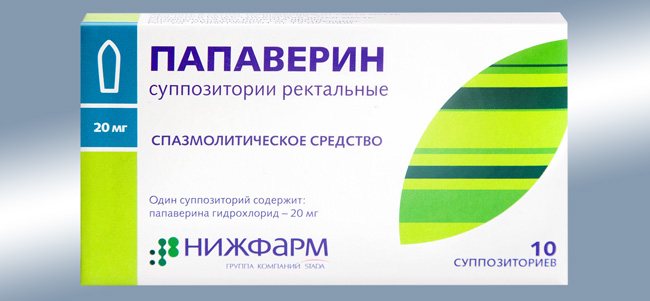
For uterine hypertonicity, suppositories are a more suitable form of the drug, since they provide a rapid and targeted supply of the required concentration of the active substance. On the other hand, knowing how long it takes for the Papaverine injection to take effect, it may seem that an injection is a more preferable option. The antispasmodic effect after the injection occurs in approximately half an hour, and for the suppositories to take effect, it takes at least two hours. What to prescribe in a particular case - suppositories or injections - should be decided by the doctor.
For any other disorders, pregnant women are advised to take tablets in the same dosage as Papaverine injections. Indications for taking the drug, which are most often found in expectant mothers, are renal colic and stomach cramps.
Reviews about Papaverine
Reviews about the pharmaceutical drug can be found on various forums and Internet resources, because the wide range of therapeutic effects of the biologically active component allows its effectiveness to be assessed by a large category of patients from various departments and with various diseases.
For example, the drug has acquired a positive reputation among proctologists and their patients, since Papaverine hydrochloride is used as a symptomatic conservative treatment for hemorrhoids, one of the most pressing problems of our time. The use of a pharmaceutical drug in the form of rectal suppositories makes it possible to facilitate the act of defecation, partially relieve pain, and eliminate the problem of bleeding from dilated hemorrhoids, which cannot but be noted in the recommendations on thematic sites.
On the other hand, one can observe positive reviews about Papaverine suppositories during pregnancy, since the antispasmodic and relaxing properties of the active ingredient can effectively relieve the problem of uterine hypertonicity, which eliminates the threat of premature birth. The biologically active substance helps relieve the cramping pain that accompanies the last weeks and days of pregnancy. The pharmaceutical drug is also used for preventive purposes in obstetric hospitals.
Papaverine price, where to buy
The pharmaceutical drug is widely known among qualified specialists and is often used in clinical practice, so its cost is not exorbitant. For example, Ukraine offers the following price list:
- price of Papaverine in ampoules – 22 hryvnia;
- rectal suppositories – 21 hryvnia;
- price of oral papaverine hydrochloride – 6 hryvnia.
In the Russian Federation, pharmacy kiosks are less constrained in setting prices for pharmaceutical products, so you can buy a medicine at the following cost:
- tablets – 10 rubles;
- injections for 1 course (packaging solution for injection with 10 ampoules) – 35 rubles;
- the price of suppositories with Papaverine is 62 rubles.
- Online pharmacies in RussiaRussia
- Online pharmacies in UkraineUkraine
- Online pharmacies in KazakhstanKazakhstan
ZdravCity
- Papaverine hydrochloride rectal suppositories.
20 mg 10 pcs. Nizhpharm OJSC 69 rub. order - Dalkhimpharm Papaverine hydrochloride solution for injection. 2% 2ml 10 pcs. JSC Dalkhimfarm
68 RUR order
- Papaverine g/chl tablets 40 mg 20 pcsPharmstandard-Leksredstva OJSC
51 RUR order
- Papaverine bufus solution for intramuscular and intravenous administration. 20mg/ml amp. polymer 2ml No. 10 RenewalАО Update PFK
132 RUR order
- Papaverine hydrochloride rectal suppositories. 20 mg 10 pcs. JSC Dalkhimfarm
64 RUR order
Pharmacy Dialogue
- Platyphylline with papaverine (Table No. 10) Vifitech CJSC
145 rub. order
- Papaverine hydrochloride bufus (amp. 2% 2 ml No. 10)Update of PFC JSC
120 rub. order
- Papaverine suppositories (supp. 20 mg No. 10)Nizhpharm JSC
60 rub. order
- Papaverine suppositories (supp. 20 mg No. 10) Biosynthesis OJSC
54 RUR order
- Papaverine h/x (tab. 40 mg No. 10) FS.-Tomskkhimpharm
13 rub. order
show more
Pharmacy24
- Papaverine hydrochloride-Darnitsa 2% 2 ml No. 10 solution PrAT" Pharmaceutical company "Darnitsa", Ukraine
46 UAH. order - Papaverine 20 mg/ml 2 ml No. 10 solution AT "Lekhim-Kharkiv", Ukraine
34 UAH order
- Analgin-dibazole-papaverine No. 10 tablets INTERCHEM Partnership with additional coverage, Ukraine
19 UAH order
PaniPharmacy
- Papaverine ampoule Papaverine liquid solution d/in. 2% amp. 2ml No. 10 Ukraine, Darnitsa ChAO
54 UAH order
- Papaverine ampoule Papaverine liquid solution d/in. 2% amp. 2ml No. 10 Ukraine, Lekhim-Kharkov CJSC
39 UAH order
- Papaverine-Health h/x tablet. 0.01g No. 10 (in box)
20 UAH order
- Papaverine ampoule Papaverine liquid solution d/in. 2% amp. 2ml No. 10 Ukraine, OZ GNTsLS LLC
40 UAH order
- Papaverine ampoule Papaverine liquid solution d/in. 2% amp. 2ml No. 10 Ukraine, Health LLC
43 UAH order
show more

